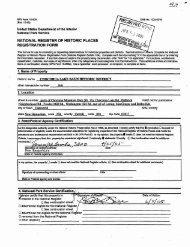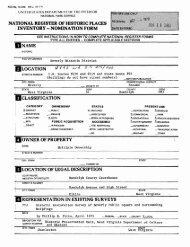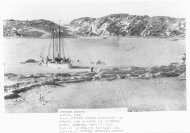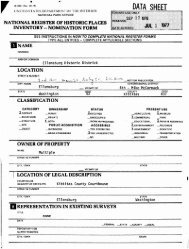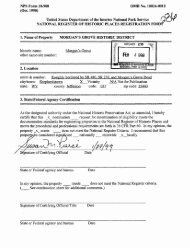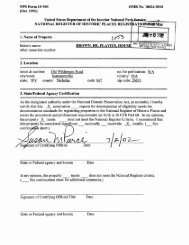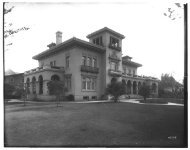National Register of Historic Places Registration Form
National Register of Historic Places Registration Form
National Register of Historic Places Registration Form
Create successful ePaper yourself
Turn your PDF publications into a flip-book with our unique Google optimized e-Paper software.
NFS <strong>Form</strong> 10-9004 OMB Approval No. 10244018<br />
(MB)<br />
United States Department <strong>of</strong> the Interior<br />
<strong>National</strong> Park Service<br />
<strong>National</strong> <strong>Register</strong> <strong>of</strong> <strong>Historic</strong> <strong>Places</strong><br />
Continuation Sheet<br />
CLEVELAND PARK HISTORIC DISTRICT<br />
WASHINGTON D.C.<br />
Section number 8 Page 19<br />
STREETCAR SUBURB TO URBAN RESIDENTIAL COMMUNITY 1894 - 1985<br />
This third phase <strong>of</strong> growth was the most prolific and was responsible for<br />
shaping the character <strong>of</strong> the neighborhood known today as Cleveland Park. The<br />
post-Civil War boom in Washington produced the tremendous growth <strong>of</strong> the city<br />
which resulted in pressures for expansion beyond its boundaries. In 1888<br />
plans were made to extend the city beyond Boundary Street (Florida Avenue) out<br />
into the "county". In the early 1890's, small subdivisions began to appear on<br />
the maps outside the city center, but the government was slow to provide the<br />
necessary amenities.<br />
Cleveland Park was made possible by Senator Francis Newlands and his<br />
dream <strong>of</strong> creating the suburb <strong>of</strong> Chevy Chase, Maryland. The Chevy Chase Land<br />
Company was responsible for laying out Connecticut Avenue, building the<br />
bridges across Rock Creek at Calvert Street and across the Klingle Gap, and<br />
constructing the tracks for the electric streetcar. The opening <strong>of</strong> streetcar<br />
service in 1890 on Wisconsin Avenue and in 1892 on Connecticut Avenue<br />
connected Cleveland Park with the city center, thus making it a viable and<br />
enviable neighborhood for persons who were primarily dependent on public<br />
transportation (because they did not own horses or carriages).<br />
In 1894-95, Thomas Waggaman and John Sherman, two Washington realtors,<br />
formed the Cleveland Park Company and began constructing houses. It appears<br />
that Waggaman was the principal landowner and financeer, whereas John Sherman,<br />
as president, was responsible for the daily construction and sale <strong>of</strong> houses<br />
from 1895 to 1909.<br />
John Sherman (1840-1925) was born in Mount Vernon, Ohio in the<br />
distinguished Sherman family. His relatives included the illustrious<br />
brothers, the General William Tecumseh Sherman and the statesman Senator John<br />
Sherman (who was a prospective Presidential candidate in 1880, 1884, and<br />
1888). These two Sherman brothers lost their father when they were quite<br />
young. Senator John Sherman, at age six, had gone to live for four years with<br />
his father's cousin who lived in Mount Vernon, Ohio. Although John" Sherman,<br />
the developer <strong>of</strong> Cleveland Park, was not alive in 1831 when the future Senator<br />
John Sherman lived with his family, it can be presumed that the relationship<br />
between the families would have been maintained so that when John Sherman<br />
moved to Washington in 1871 he would have been in touch with his relative John<br />
Sherman who was already a Senator and representing his home state.<br />
John Sherman, <strong>of</strong> Cleveland Park, graduated from Kenyon College, Ohio and<br />
then studied law for several years at Winona, Minnesota before moving to<br />
Washington D.C. He and his wife were members <strong>of</strong> the Church <strong>of</strong> the Epiphany.<br />
John Sherman was a founder <strong>of</strong> St. Stephens Episcopal Church and was also for<br />
many years a vestryman <strong>of</strong> the Rock Creek Church. He was active in real estate<br />
throughout the District <strong>of</strong> Columbia, but his most significant development<br />
project seems to have been the establishment <strong>of</strong> Cleveland Park. Many<br />
subdivisions were laid out at this time, but Cleveland Park established itself<br />
much more quickly than the others.<br />
In accordance with the Act <strong>of</strong> 1888 regulating the subdivision <strong>of</strong> xand in



